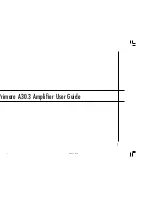
31
KAW
Section 5
Precautions & Cleaning
5.1 Precautions when Using Wireless
While wireless systems have freed performers from the bonds of cords and cables, they've unleashed
several headaches for the sound crew. Getting a wireless system to behave predictably is a challenge
faced by touring professionals and newbies alike. No one and no system is immune.
Understanding the basics of how wireless systems and radio waves function will help everyone
triumph over dropouts, interference and distortion. Start now by avoiding these common errors.
1. Signal blockage
Maintain line-of-sight between the transmitter and receiver antennas as much as possible. Avoid
metal objects, walls, and large numbers of people between the receiving antenna and its
associated transmitter. Ideally, this means that receiving antennas should be in the same room
as the transmitters and elevated above the audience or other obstructions. The human body will
absorb, block, interfere, and reflect the RF (Radio Frequency) signal emitted by a wireless
mic transmitter. Largely composed of salty water, human bodies soak up RF energy. In addition,
if a user cups his or her hands around the external antenna on a handheld transmitter, its effective
output can be reduced by 50 percent or more.
2. Incorrect antenna type or placement
Receiver antennas are one of the most misunderstood areas of wireless microphone operation.
Mistakes in antenna selection, placement, or cabling can cause short range, dead spots in the
performance area or low signal strength at the receiver that leads to frequent dropouts. Modern
diversity receivers offer much better performance than single-antenna types, but the proper
antennas must still be put in the proper locations to maximize the performance and reliability of
the system.
To ensure good diversity performance, space antennas apart by at least one-quarter of a
wavelength (about 13 centimetres at 600 MHz). One wavelength (about 50 centimetres at 600
MHz) is even better. The receiver antennas should be angled apart in a wide "V" configuration,
which provides better pickup when the transmitter is moving around and being held at different
angles.
Try to keep antennas as close to transmitters with line of sight as is possible. Antennas can also
be frequency band specific. Don't try to use an antenna from another system without double-
checking the frequencies first.
If the receiver will be located away from the performance area (in an equipment closet or a closed
rack, for example), ½-wave antennas or directional antennas should be remotely mounted (ideally
above the audience) in order to have a clear line of sight to the transmitters.
(Short ¼-wave
antennas should never be remotely mounted, however, because they need the receiver
chassis as a ground plane.)
Increasing the separation between diversity antennas up to one
wavelength (about 50 centimetres at 600 MHz) will improve diversity performance. Beyond one
wavelength, extra distance between the antennas will not significantly improve diversity
performance, but may allow better coverage of a large stage, church, or meeting room.
If the antennas will be far from the stage, use directional antennas to improve reception by picking
up more signal from that direction and less from other angles.
If the antennas will be connected to the receiver with a length of coaxial cable, in-line antenna
amplifiers may be required to overcome the inherent signal loss in the cable. The amount of loss
depends on the exact length and type of cable used, so follow the manufacturer's
recommendations. Total net loss should not exceed 5 dB.






































